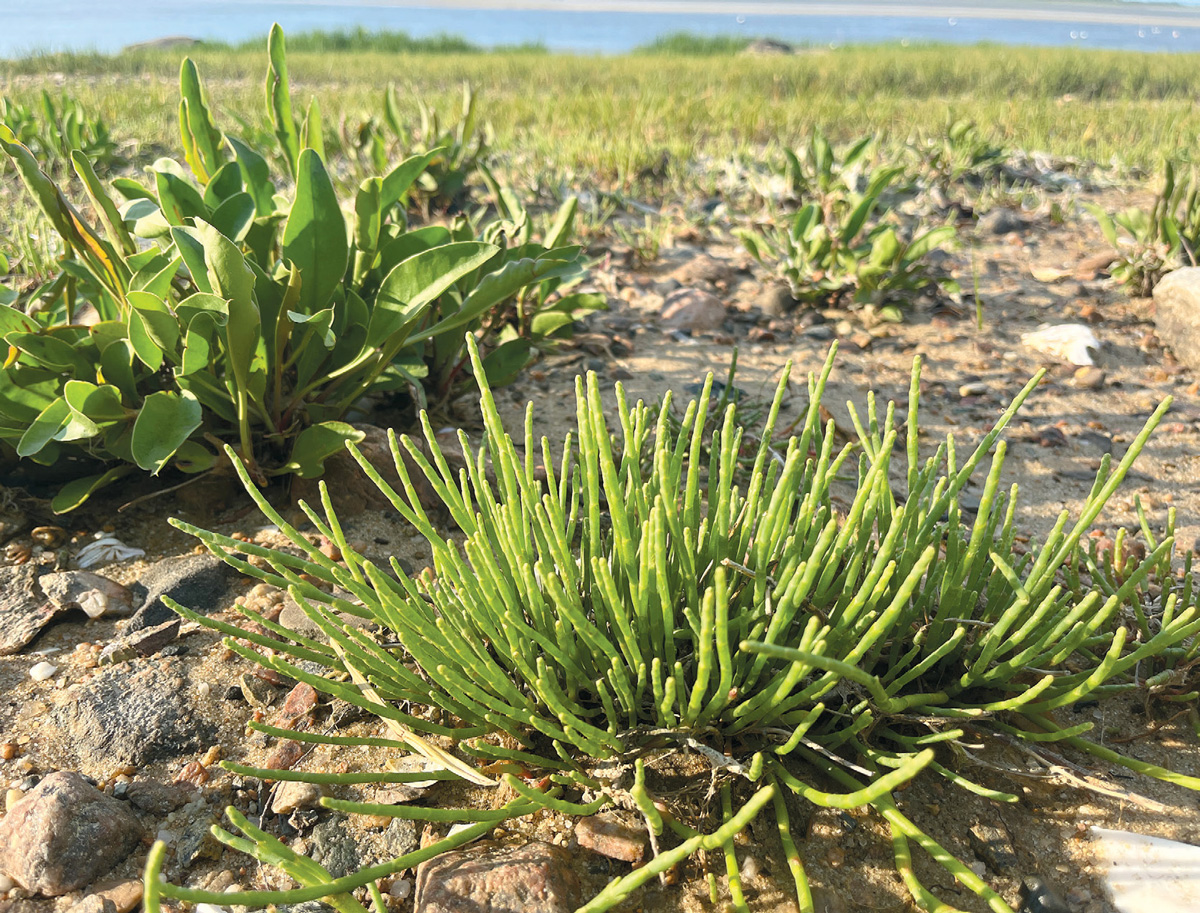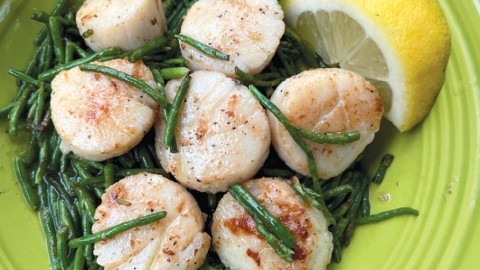Eating Wild - Sea Bean: A Briny Delight
One of my favorite aspects of foraging is the way that different growing conditions offer different opportunities to discover wild edible plants. The woods will provide the perfect conditions for one plant (see wintergreen), while the forest’s edge will be teeming with a host of others (see lady’s thumb, Asiatic dayflower, and lamb’s quarters). The marsh presents a completely different opportunity for plant discovery (like the endlessly useful cattail), while the rocky coast offers yet another (like the spinach-like leafy green, orache).
On Cape Cod, we are lucky enough to have a huge variety of environments in which to forage, and where we can stumble across or go searching for specific plants that might not be able to grow a mile – or even a few feet – away. I’ve written here about plants that can be found in many of the environments listed above, and it is on our Northeastern coastal shoreline where a particularly unique edible plant, the sea bean, can be found.
Sea bean (the Salicornia species) is a plant that goes by a wide variety of common names including samphire, glasswort, beach asparagus, and pickleweed. It belongs to the expansive Amaranthaceae family of plants, which includes many of our more common edible greens, both wild and cultivated, like the previously mentioned lamb’s quarters and orache, as well as amaranth and the spinach we grow in our gardens.
Unlike the majority of the plants we dedicated foragers look for in the Northeast, which tend to thrive farther inland, sea bean grows in the salty and sandy ground leading right up to the water’s edge. This is an unassuming little plant, and can often blend right into the other greenery, particularly the beach grass, that makes New England beaches so picturesque. Though closely related to many edible plants that we’d traditionally call leafy, sea bean itself looks nothing like those more typically salad-like greens, nor does it actually look like the beach grass that often surrounds it.
Upon closer inspection, it becomes clear that sea bean is, in fact, a succulent that presents almost like tiny communities of finely segmented Saguaro cacti (though without the arms). Once you do see it, you will realize that the one small patch you originally spied is actually one of many – a veritable carpet that looks a bit like a desert landscape in miniature – and it will forever change how you see the shoreline around you.
Sea bean is easy to harvest, but does require a bit of care to pick properly. The plants themselves are delicate and easy to crush underfoot, so harvest sea bean stems from patches on the edges of where you find them growing instead of walking on top of the plants. You should also only pick the top 2-6 inches of the sea bean you find, since the rest of the plant will recover as long as the roots and bottoms of the stems remain intact. The stems are very segmented, making it easy to find connecting joints where you can cut your harvest. Sea bean can be picked throughout the growing season, from spring through fall, and the plant will often take on a reddish tone later in the year as the weather cools. As always with foraging, make sure that you are leaving the vast majority of what you find for wildlife and to conserve the local ecosystem, and since different natural spaces have different types of regulations, make sure that you check local guidelines and harvest appropriately for each space.
I have found large swaths of sea bean along the Northeastern coastline all the way to northern Maine, and I nearly always overlook it at first. But keep your eyes peeled and you will be in for a treat, since the flavor of sea bean is both delicious and unlike any other wild edible plant I prepare in my kitchen. Because of the saline environment in which it thrives, sea bean has a distinctly briny flavor that – as several of its common names indicate – makes it taste as if it has been pickled. As someone who cans and ferments jars and jars of briny vegetables each fall, sea bean is right up my alley, and I am thrilled every time I happen upon this versatile little plant.
Once I get my bundle of briny plants home, my go-to preparation is to simply clean, chop, and quickly sauté the harvest in a bit of olive oil or butter (tossing in some minced garlic or shallots if you like). It can then be added into all sorts of dishes that would benefit from a little savory crunch. The brininess of sea bean also makes it a perfect vegetable to pair with other foods harvested from the sea, so while I will happily mix my cooked sea bean into a cold pasta salad or toss some into an omelet or frittata, I find they are at their best when used as a bed for seared shellfish like scallop or lobster, or a meatier fin fish, such as tuna or swordfish. If you find a smaller patch of sea bean you should treat your harvest more as a topping than a bed, scattering the lightly sautéed pieces over the top of your seafood after cooking. A topping of chopped and sautéed sea bean adds a bright green pop of color (much like adding a bit of parsley or chives would) and will boost the salt content of your finished dish.
Sea bean’s already pickle-like nature also makes it the perfect vegetable to turn into a relish for hot dogs or sausage. Simply heat up a vinegar-based brine, dissolving a bit of sugar to your flavor preference. I like to use cider vinegar for my brines, and often add mustard seeds, some whole peppercorns, and a small pinch of turmeric. Pour the hot brine over your sea bean in a heat-safe jar and let it sit for a few hours, until it cools completely, before using.
There are many reasons to appreciate our diverse Cape Cod landscape, and the many opportunities it presents to work, recreate, and interact with nature. As you take the time to connect with the animal and plant life around you, remember that even the smallest change in your surroundings can present a completely different environment to see, to engage with, and to learn from. And sometimes – if you’re lucky – part of what you’ll discover will be a delightful new ingredient that you had no idea was there, just around the corner.
*NOTE: Always consult with trusted experts and refer to foraging books and field guides for 100% positive plant identification before consuming any wild plant, and make sure you are familiar with every potentially dangerous plant that grows in your region. As with harvesting any wild plant, and particularly ones that grow in commonly sprayed areas, take particular care to collect from spaces you know to be chemical-free. Never pick any wild plant from protected spaces. Integrate new foods into your diet in small quantities to gauge any dietary and allergy sensitivities, and consult with a doctor if you have any questions or concerns about specific health issues or medication interactions.
Becca Miller lives in the Adirondack Mountains and works as a professional farm-to-classroom educator, ceramics teacher, writer, and photographer. A former Cape Codder in residence but always a Cape Codder at heart, Becca spent her time living on the Cape running a CSA program where she taught members how to use harvest items in new and creative ways. Becca is a Certified Master Food Preserver and a Leave No Trace Trainer, and her writing has been featured in Edible Capital District, Edible Vermont, and Adirondac magazines, along with Alice Waters’ Edible Schoolyard blog and Mother Earth Living’s Food Matters blog. Find Becca’s writing at beccamillerwriting.weebly.com.







